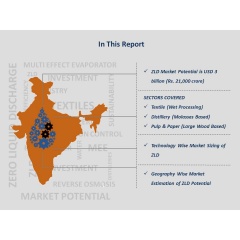March to Sustainability: Zero Liquid Discharge
Total Market Potential of ZLD Estimated to be USD 3 Billion by 2020
13th June 2016, New Delhi
March to Sustainability: Zero Liquid Discharge, is an in depth market assessment report, which describes the current scenario, illustrates the outlook for 2020 and quantifies the investment opportunity with a focus on three highly polluting and water intensive industries, i.e. Textile (wet processing), Distillery (molasses based) and Pulp & Paper (large wood based).
The nation afflicted by water security crisis has necessitated actions to ensure reduction of industrial water footprint. Currently, Indian industries are operating well below the global best scenarios and are one of the prime reasons behind pollution of the water resources. Zero Liquid Discharge in this scenario is a welcome move and is expected to have an accelerated uptake in the coming years.
The report highlights that the textile (wet processing) sector accounts for the largest share in the cumulative potential of USD 3 billion (INR 210 billion) for the three focus sectors by 2020. Though ZLD has a significant impact on the cost of production in the wet processing segment, the impact on final product (garment in this case) is not very substantial.
Molasses based distilleries sector follows second in terms of market share of ZLD. This is in line with the fact that both textiles and distilleries already have regional mandates for ZLD and have a national mandate in the pipeline. The distilleries sector have a relatively strong business case for ZLD due to the additional revenue from by-products generated as a result of adoption of bio-compositing as a route for achieving ZLD in the sector.
The Pulp & Paper sector at present does not have any ZLD mandate, however the Charter for Water Recycling & Pollution Prevention in Pulp & Paper Industry aims at making the industry efficient and sustainable in terms of water use. The industry is currently operating well below the global standards and is highly inefficient in terms of water use and also a major contributor to the pollution of India’s water resources. Of the three sub-segments (based on raw material used), the large wood based pulp & paper mill are highly polluting and much worse with respect to global specific water consumption of ~29 m3/MT. Thus, there is a high probability that the large wood based pulp & paper mill will be targeted first to lead the Pulp & Paper industry towards Zero liquid Discharge. Once the industry achieves the global best level of water consumption, it is likely that the market opportunities for ZLD solutions would open for the sector and the investment would pick up by 2020.
The report also ascertains the geographies of highest market potential in each of the three sectors. The actual market penetration of ZLD would primarily be governed by how the policy landscape shapes up in the next few years. In the near term, the potential market would be focused on the Ganga basin states but with the onset of the national mandate, other states are expected to climb the ladder to become the hotspots for market potential in this domain. The report analyzes and estimates the potential market for ZLD solution across different states of India for each of the focus sectors.
The report also provides an in-depth assessment of the technology options for achieving ZLD in the three industries. Reverse Osmosis (RO) and Multiple Effect Evaporator (MEE) are the key components of ZLD solution in these three sectors of focus. The market size for each of these components has also been estimated in this report.
There is high market opportunity for ZLD solutions in these sectors, however, there are a few roadblocks for the industries to achieve ZLD like low price of water leading to weak business case, high cost of implementation leading to reduced cost competitiveness in the national and global markets, lack of financing sources, disposal of solid by-product in certain sectors, escalated carbon footprint of the industry, technology limitations. Achieving ZLD by the industry is the need of the hour, although is difficult. The actual market penetration would primarily be governed by the policy landscape in 2020. In order to smoothen out the implementation pressures and drive the action agenda, focus should be on models of operation and capacity building of operators within industrial units which have been dealt in detail in the report.
The report, March to Sustainability: Zero Liquid Discharge can be accessed here.
Media Contact
Anushua Chowdhury
Sustainability Outlook
achowdhury@sustainabilityoutlook.in
91.11.4050.7277
91.971.784.9920
About Sustainability Outlook
Sustainability Outlook, a division of cKinetics, is a market intelligence, discovery and collaboration platform facilitating sustainability linked actions amongst businesses, policy makers and investors. Sustainability Outlook actively tracks and provides market insights in resource management with focus on policy, technology and finance to work towards creating closed loop systems. Solutions offered by Sustainability Outlook include State of Sector Reports, Market development platforms, tools and frameworks for enabling and promoting resource sustainability within the industry, Regulatory and policy analysis and Resource inventorization studies amongst others.
http://sustainabilityoutlook.in
( Press Release Image: https://photos.webwire.com/prmedia/39961/203611/203611-1.jpg )
WebWireID203611
- Contact Information
- Anushua Chowdhury
- Analyst
- (+91)-9717849920
- (91) 40507277
- achowdhury@sustainabilityoutlook.in
This news content may be integrated into any legitimate news gathering and publishing effort. Linking is permitted.
News Release Distribution and Press Release Distribution Services Provided by WebWire.
